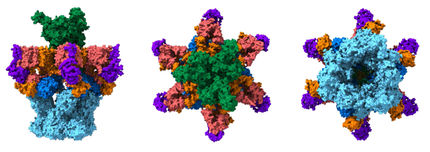Blood test for tuberculosis
Biomarkers may be able to predict the risk of developing tuberculosis in future
Together with AIDS, tuberculosis ranks among those infectious diseases with the highest global mortality rate, claiming the lives of between 1.5 and two million people every year. However, not everyone infected with the bacterium develops tuberculosis. In fact, fewer than ten percent of those infected go on to manifest the disease. An international team of scientists, including researchers from the Max Planck Institute for Infection Biology in Berlin, have now developed a tuberculosis test that can reliably predict whether an individual will develop active tuberculosis. Doctors may be able to use this test in future to predict the progression of the disease and initiate medical care early.

In future, molecules from blood samples can tell physicians if somebody will develop tuberculosis.
© MPG/ J. Steengard
Around 4000 people die of tuberculosis every day and around a third of the world’s population are infected by the causative pathogen, the Mycobacterium tuberculosis bacterium; however, around 90 percent of those infected remain free of symptoms throughout life. In such cases of latent tuberculosis, the bacteria remain dormant in the body without triggering active disease. People with a weak or weakened immune system, for example the very young and very old as well as individuals with other diseases such as HIV or diabetes, are more likely to develop active tuberculosis. A poor diet and poor social conditions are further risk factors.
The blood counts of individuals with latent or active tuberculosis differ from each other. Nevertheless, until now it has not been possible to predict whether an individual with Mycobacterium tuberculosis infection will develop active tuberculosis.
In a recently published study, scientists developed a blood test based on biomarkers that can predict whether active tuberculosis will develop with a reliability of around 75 percent. A biomarker can be a cell, gene or molecule, such as enzymes or hormones, by means of which doctors can detect changes in the body. In order to detect differences between latent and active tuberculosis, scientists of the South African Tuberculosis Vaccine Initiative (SATVI) and the Center for Infectious Disease Research (CIDR) analyzed the gene activity in blood samples obtained from more than 10,000 people in South Africa and Gambia, and then observed the subjects for two years.
Prediction of tuberculosis by gene activity
The results show that specific genes in immune cells are active in the blood of individuals who later develop active tuberculosis. In future, a blood test for gene activity will be able to identify the activity pattern typical of potential tuberculosis patients. “Such a test could predict the occurrence of the disease more than a year before the disease develops,” says the head of the study, Willem Hanekom of the University of Cape Town. “This long lead period will give doctors enough time to initiate treatment.” The blood test will now be tested in clinical trials to determine whether progression of the predicted disease can be halted with targeted treatment.
Stefan H.E. Kaufmann of the Max Planck Institute for Infection Biology, who was also involved in the study, is spearheading a similar study that is examining groups of subjects from various parts of Africa, including South Africa, Malawi, Uganda, Ethiopia and Gambia. The aim of the study is to develop a pan-African biomarker test for tuberculosis that also takes into account differences between patient populations and pathogen types. The results of the parallel study, which will be published at the end of the year, have identified the same telltale gene profile indicating an increased risk of active tuberculosis. “If we can predict early on that an individual will develop active tuberculosis, this will help greatly in containing the disease. In addition, we can now identify individuals at high risk of developing tuberculosis and include them in clinical trials for new medications and vaccines. This will reduce the number of trial subjects needed and the duration of trials, and will also significantly cut the costs of trials,” Kaufmann explains.
Original publication
Daniel E. Zak, Adam Penn-Nicholson, Thomas J. Scriba et al.; "A prospective blood RNA signature for tuberculosis disease risk"; The Lancet; 23 March, 2016





















































